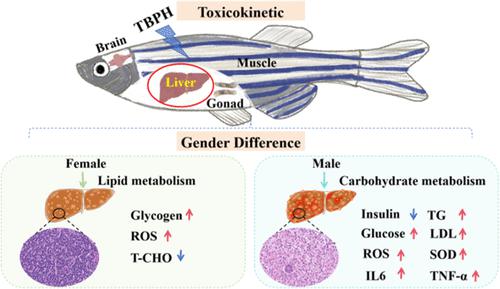当前位置:
X-MOL 学术
›
Environ. Sci. Technol.
›
论文详情
Our official English website, www.x-mol.net, welcomes your feedback! (Note: you will need to create a separate account there.)
Bis(2-ethylhexyl)-tetrabromophthalate Poses a Higher Exposure Risk and Induces Gender-Specific Metabolic Disruptions in Zebrafish Liver
Environmental Science & Technology ( IF 11.4 ) Pub Date : 2024-03-06 , DOI: 10.1021/acs.est.4c00234 Kaiyu Fu 1, 2 , Biran Zhu 1, 3 , Yumiao Sun 1, 4 , Yuxi Zhou 1, 2 , Hao Pang 5 , Xinxin Ren 1, 2 , Yongyong Guo 1 , Xiongjie Shi 6 , Jian Han 1 , Lihua Yang 1 , Bingsheng Zhou 1
Environmental Science & Technology ( IF 11.4 ) Pub Date : 2024-03-06 , DOI: 10.1021/acs.est.4c00234 Kaiyu Fu 1, 2 , Biran Zhu 1, 3 , Yumiao Sun 1, 4 , Yuxi Zhou 1, 2 , Hao Pang 5 , Xinxin Ren 1, 2 , Yongyong Guo 1 , Xiongjie Shi 6 , Jian Han 1 , Lihua Yang 1 , Bingsheng Zhou 1
Affiliation

|
Bis(2-ethylhexyl)-tetrabromophthalate (TBPH), a typical novel brominated flame retardant, has been ubiquitously identified in various environmental and biotic media. Consequently, there is an urgent need for precise risk assessment based on a comprehensive understanding of internal exposure and the corresponding toxic effects on specific tissues. In this study, we first investigated the toxicokinetic characteristics of TBPH in different tissues using the classical pseudo-first-order toxicokinetic model. We found that TBPH was prone to accumulate in the liver rather than in the gonad, brain, and muscle of both female and male zebrafish, highlighting a higher internal exposure risk for the liver. Furthermore, long-term exposure to TBPH at environmentally relevant concentrations led to increased visceral fat accumulation, signaling potential abnormal liver function. Hepatic transcriptome analysis predominantly implicated glycolipid metabolism pathways. However, alterations in the profile of associated genes and biochemical indicators revealed gender-specific responses following TBPH exposure. Besides, histopathological observations as well as the inflammatory response in the liver confirmed the development of nonalcoholic fatty liver disease, particularly in male zebrafish. Altogether, our findings highlight a higher internal exposure risk for the liver, enhancing our understanding of the gender-specific metabolic-disrupting potential associated with TBPH exposure.
中文翻译:

双(2-乙基己基)-四溴邻苯二甲酸酯具有较高的暴露风险,并会导致斑马鱼肝脏中性别特异性代谢紊乱
双(2-乙基己基)-四溴邻苯二甲酸酯(TBPH)是一种典型的新型溴化阻燃剂,已在各种环境和生物介质中广泛存在。因此,迫切需要在全面了解内照射及其对特定组织的相应毒性作用的基础上进行精确的风险评估。在本研究中,我们首先使用经典的伪一级毒代动力学模型研究了不同组织中TBPH的毒代动力学特征。我们发现,TBPH 更容易在雌性和雄性斑马鱼的肝脏中积聚,而不是在性腺、大脑和肌肉中积聚,这凸显了肝脏的内暴露风险较高。此外,长期暴露于环境相关浓度的TBPH会导致内脏脂肪积累增加,表明潜在的肝功能异常。肝脏转录组分析主要涉及糖脂代谢途径。然而,相关基因和生化指标的变化揭示了TBPH暴露后的性别特异性反应。此外,组织病理学观察以及肝脏的炎症反应证实了非酒精性脂肪肝的发展,特别是在雄性斑马鱼中。总而言之,我们的研究结果强调了肝脏的较高内暴露风险,增强了我们对与 TBPH 暴露相关的性别特异性代谢干扰潜力的理解。
更新日期:2024-03-06
中文翻译:

双(2-乙基己基)-四溴邻苯二甲酸酯具有较高的暴露风险,并会导致斑马鱼肝脏中性别特异性代谢紊乱
双(2-乙基己基)-四溴邻苯二甲酸酯(TBPH)是一种典型的新型溴化阻燃剂,已在各种环境和生物介质中广泛存在。因此,迫切需要在全面了解内照射及其对特定组织的相应毒性作用的基础上进行精确的风险评估。在本研究中,我们首先使用经典的伪一级毒代动力学模型研究了不同组织中TBPH的毒代动力学特征。我们发现,TBPH 更容易在雌性和雄性斑马鱼的肝脏中积聚,而不是在性腺、大脑和肌肉中积聚,这凸显了肝脏的内暴露风险较高。此外,长期暴露于环境相关浓度的TBPH会导致内脏脂肪积累增加,表明潜在的肝功能异常。肝脏转录组分析主要涉及糖脂代谢途径。然而,相关基因和生化指标的变化揭示了TBPH暴露后的性别特异性反应。此外,组织病理学观察以及肝脏的炎症反应证实了非酒精性脂肪肝的发展,特别是在雄性斑马鱼中。总而言之,我们的研究结果强调了肝脏的较高内暴露风险,增强了我们对与 TBPH 暴露相关的性别特异性代谢干扰潜力的理解。





























 京公网安备 11010802027423号
京公网安备 11010802027423号